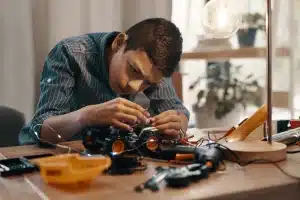The Art and Science of Toy Testing and Quality Control
Introduction
Quality control is an essential aspect of the toy industry. With the
importance of ensuring the safety and enjoyment of children, toy testing
has become both an art and a science. Manufacturers and retailers invest
significant resources to ensure that their toys meet stringent quality
standards. In this article, we will explore the fascinating world of toy
testing and quality control, uncovering the key features and processes
involved.
The Importance of Toy Testing
Toy testing serves as a crucial step in the manufacturing process.
Ensuring that toys are safe, durable, and meet regulatory requirements is
not only a legal obligation but also a moral responsibility. Here are
some of the key reasons why toy testing is of utmost importance:
-
Safety
The safety of children is paramount. Toy testing helps identify and
mitigate potential risks such as choking hazards, sharp edges, or
toxic substances. -
Durability
Toys must withstand the playful nature of children. Rigorous testing
ensures that toys can withstand various forces and usage patterns,
thereby reducing the likelihood of accidents or breakages during play. -
Compliance
Toy manufacturers must comply with strict regulatory standards. Testing
verifies if toys meet requirements set by organizations such as the
Consumer Product Safety Commission (CPSC) or the European Union’s EN71
standard. -
Brand Reputation
A strong brand reputation is built on trust. Thorough toy testing
demonstrates a commitment to quality and safety, enhancing a brand’s
image and credibility among consumers and retail partners.
The Toy Testing Process
Toy testing involves a comprehensive process that evaluates various aspects
of a toy’s safety, functionality, and quality. Though the specifics may
vary depending on the toy’s nature, here are the general steps involved:
-
Design Concept Assessment
At the early stages of toy development, a conceptual assessment is
conducted to evaluate potential risks and safety concerns associated
with the toy’s design. This phase helps identify and rectify any issues
before proceeding further. -
Raw Material Testing
Testing the materials used in toys is essential to ensure compliance
with safety regulations. This involves analyzing the chemical composition
and physical properties of materials to identify potential hazards. -
Product Functionality Testing
This phase focuses on evaluating a toy’s functionality and performance.
It includes tests such as checking battery life, movement capabilities,
and any special features or functions. -
Safety Testing
Safety testing encompasses a range of assessments, including mechanical
and physical properties tests, flammability tests, and toxicological
evaluations. These tests ensure that the toy meets safety standards and
does not pose any immediate or long-term risks to children. -
Age Grading Verification
Toys are often labeled with recommended age ranges. Age grading
verification ensures that toys are appropriate for the intended age
group, taking into consideration factors such as small parts, choking
hazards, or complex features that could pose risks to younger children. -
Packaging and Labeling Assessment
The packaging of a toy plays a vital role in providing necessary
information to consumers. Assessing packaging and labeling helps
ensure accurate age recommendations, proper instructions, and warning
labels, enhancing consumer awareness and safety.
Toys and Quality Control Features
Quality control features are integral to ensuring well-crafted and safe
toys. Manufacturers focus on implementing the following features during
the production and testing phases:
-
Durable Materials
Toys made from durable materials, such as high-quality plastics or
reinforced fabrics, enhance longevity and reduce the risk of
breakages or accidents during play. -
Non-Toxic Components
Ensuring that toys are free from harmful substances, such as lead or
phthalates, is crucial. Quality control verifies compliance with
regulatory guidelines to guarantee the safety of children. -
Secure Fastenings
Toys with small components or detachable parts undergo rigorous testing
to ensure that fastenings are secure. This helps prevent choking hazards
and minimizes the risk of accidental swallowing or injuries. -
Design Optimization
Quality control focuses on refining toy design to maximize safety and
appeal. Rounded edges, smooth surfaces, and age-appropriate features
contribute to a toy’s overall quality and reduce potential risks. -
Quality Assurance Checks
Thorough quality assurance checks are conducted throughout the toy
manufacturing process. These checks encompass inspections at various
stages, including material sourcing, assembly, and final product
assessment, guaranteeing consistent quality and adherence to standards.
Conclusion
The art and science of toy testing and quality control play a pivotal role
in ensuring safe and enjoyable play experiences for children. Toy testing
not only satisfies regulatory requirements but also helps build trust,
protect brand reputation, and ultimately bring smiles to children’s faces.
By adhering to stringent quality control measures and embracing innovative
testing methodologies, the toy industry upholds the highest standards,
enriching the lives of young ones worldwide.





